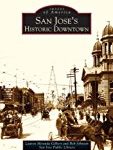Art & history citinerary… in downtown San Jose… on the 240th anniversary of San Jose!
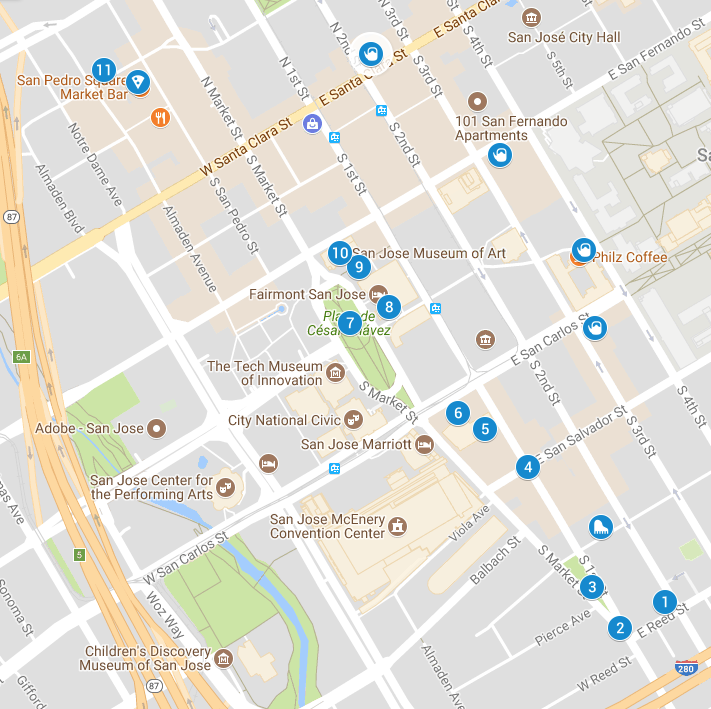
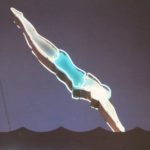 In the 1950s and 1960s, diving ladies appeared on US motel signs to advertise the presence of swimming pools. Once a common sight off the American roadside, these signs have become increasingly rare. This neon diver sign arrived at San Jose’s City Center Motel around 1960. It is one of only TWO original motel sign divers left in the entire state of California.
In the 1950s and 1960s, diving ladies appeared on US motel signs to advertise the presence of swimming pools. Once a common sight off the American roadside, these signs have become increasingly rare. This neon diver sign arrived at San Jose’s City Center Motel around 1960. It is one of only TWO original motel sign divers left in the entire state of California.
Do you know where is the other sign? The history of San Jose (1st pueblo, 1777) is similar to Los Angeles (2nd pueblo, 1781).
The history of San Jose (1st pueblo, 1777) is similar to Los Angeles (2nd pueblo, 1781).
Imagery is rendered in tile murals and bas-relief sculpture.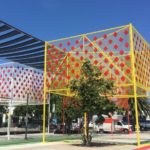 Anchored by four steel cage pavilions — “urban rooms” — this park seeks to transform into a platform for cultural events and programs. There’s also a permanent event stage and curtains that can divide the space into smaller areas or direct pedestrians through the plaza.
Anchored by four steel cage pavilions — “urban rooms” — this park seeks to transform into a platform for cultural events and programs. There’s also a permanent event stage and curtains that can divide the space into smaller areas or direct pedestrians through the plaza.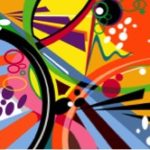 This artful intersection is in the South First Area (SoFA) that serves as downtown San Jose’s arts and entertainment district with rich architecture, art galleries, music venues and cultural events. Cool, organic and creative, SoFA is a place where visitors can interact with some of the most eclectic and artistic people in the city. The design may be experienced up close and afar expresses funky and dynamic abstract energy to echo the unconventional, artistic and dynamic character of the community.
This artful intersection is in the South First Area (SoFA) that serves as downtown San Jose’s arts and entertainment district with rich architecture, art galleries, music venues and cultural events. Cool, organic and creative, SoFA is a place where visitors can interact with some of the most eclectic and artistic people in the city. The design may be experienced up close and afar expresses funky and dynamic abstract energy to echo the unconventional, artistic and dynamic character of the community.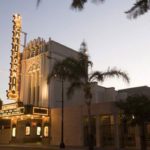 This historic venue, originally known as the Fox Theatre, was designed in 1927 by architects Weeks and Day and once said to be “the finest theater in California.”
This historic venue, originally known as the Fox Theatre, was designed in 1927 by architects Weeks and Day and once said to be “the finest theater in California.”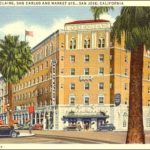 It is a timeless landmark dating back to 1926. Situated in the heart of downtown, it was visioned to be the root of the city’s growing social and cultural life. Once the site of the Eagle Brewery closed by prohibition in 1918, its ground-breaking took place in September, 1925. Upon completion exactly one year later with construction and furnishing costs totaling $1,000,000, it became known as San Jose’s “Million Dollar Hotel”.
It is a timeless landmark dating back to 1926. Situated in the heart of downtown, it was visioned to be the root of the city’s growing social and cultural life. Once the site of the Eagle Brewery closed by prohibition in 1918, its ground-breaking took place in September, 1925. Upon completion exactly one year later with construction and furnishing costs totaling $1,000,000, it became known as San Jose’s “Million Dollar Hotel”.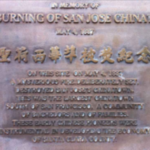 “On this site on May 4, 1887 a mysterious fire, deliberately set, destroyed San Jose’s Chinatown. This was the largest Chinatown south of San Francisco, a community of bachelors and of families. These early Chinese pioneers were instrumental in developing the economy of Santa Clara County.“
“On this site on May 4, 1887 a mysterious fire, deliberately set, destroyed San Jose’s Chinatown. This was the largest Chinatown south of San Francisco, a community of bachelors and of families. These early Chinese pioneers were instrumental in developing the economy of Santa Clara County.“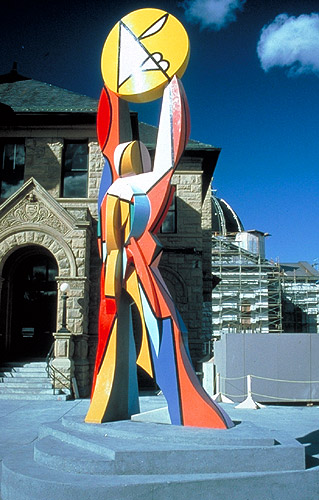 A striking sculpture of brilliant colors! Like so many of his public art installations, this work by Italo Scanga immediately grabs you into the space in which the piece is placed. Other such examples of Scanga sculptures include the whimsical figures “Continents” at the San Diego International Airport. Imagery to make you smile, these public installations are happy, colorful and fun. Scanga was a master of color and form. Utilizing extremely bright hues in defined blocks of color against subtle tones, Scanga was able to turn color & form into statements you cannot ignore. The Calabria-born artist lived from 1932 to 2001. He moved to the US in 1947 and set the world on fire with his original art. He eventually lived in La Jolla and taught at the University of California San Diego. He acquired two gallery studios in San Diego and also worked on creating a museum of his work in his hometown of Lago, Calabria.
A striking sculpture of brilliant colors! Like so many of his public art installations, this work by Italo Scanga immediately grabs you into the space in which the piece is placed. Other such examples of Scanga sculptures include the whimsical figures “Continents” at the San Diego International Airport. Imagery to make you smile, these public installations are happy, colorful and fun. Scanga was a master of color and form. Utilizing extremely bright hues in defined blocks of color against subtle tones, Scanga was able to turn color & form into statements you cannot ignore. The Calabria-born artist lived from 1932 to 2001. He moved to the US in 1947 and set the world on fire with his original art. He eventually lived in La Jolla and taught at the University of California San Diego. He acquired two gallery studios in San Diego and also worked on creating a museum of his work in his hometown of Lago, Calabria.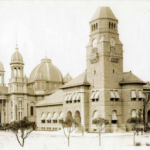 This building was once the San Jose Post Office. The Romanesque-style Post Office was completed in 1895. Made of sandstone from a quarry in Almaden Valley, it was built by the same Italian stonemasons who created the quadrangle at Stanford University.
This building was once the San Jose Post Office. The Romanesque-style Post Office was completed in 1895. Made of sandstone from a quarry in Almaden Valley, it was built by the same Italian stonemasons who created the quadrangle at Stanford University.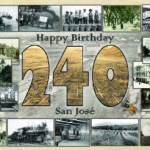 The adobe was built in 1797 by Manuel Gonzelez, an Apache Indian — also the first resident, and second mayor, of San Jose. The second occupant was Luís María Peralta, who held the highest office in the community as commissioner. Both were part of the Juan Bautista de Anza expedition. The adobe is the last remaining structure from El Pueblo de San José de Guadalupe. See the Adobe’s horno, an outside working oven, or venture inside the home and see two rooms furnished as they might have been when they were occupied by the Gonzalez and Peralta families.
The adobe was built in 1797 by Manuel Gonzelez, an Apache Indian — also the first resident, and second mayor, of San Jose. The second occupant was Luís María Peralta, who held the highest office in the community as commissioner. Both were part of the Juan Bautista de Anza expedition. The adobe is the last remaining structure from El Pueblo de San José de Guadalupe. See the Adobe’s horno, an outside working oven, or venture inside the home and see two rooms furnished as they might have been when they were occupied by the Gonzalez and Peralta families.
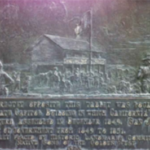 “Directly opposite this tablet was located the first state capitol building in which California’s first legislature assembled in December 1849. San Jose was the seat of government from 1849 to 1851”
“Directly opposite this tablet was located the first state capitol building in which California’s first legislature assembled in December 1849. San Jose was the seat of government from 1849 to 1851”
ADDRESSES
- City Center Motel
- Commemoration of the Founding of the Pueblo San José de Guadalupe
- Parque de los Pobladores
- SoFA Intersection Design
- California Theatre
- St Claire Hotel – The Westin
- The Plaza
- San Jose’s Chinatown
- Figure Holding the Sun, Italo Scanga, 1988
- Old San Jose Post Office – San Jose Museum of Art
- Peralta Adobe – Fallon House Historic Site
45 E. Reed Street
The other diver SIGN is at the Villa Capri Motel in Coronado
East Los Streetscapers, 1997
S. Market St. at S. First St.
510 S. First St.
1st and San Salvador streets
345 S 1st St.
The Westin, 302 S Market St.
Plaza de César Chávez
Fairmont Hotel, 172 S Market St
110 S Market St.
110 S Market St.
175 West Saint John St.
MAP
PDF: Downtown San Jose
- California Historical Landmarks By County
- History San Jose: preserves and enriches the cultural heritage of San Jose and the Santa Clara Valley through research, collections, partnerships, educational programs and events.
- A Walk Around Downtown San Jose and the Importance of Public Spaces
- Exhibition District
- History San Jose
- San Jose’s California Theatre – Photos
- San Jose Downtown: Street Life
- San Jose Tours: Downtown San Jose Public Art Walk
- San Jose Walks & Talks: serves the community by highlighting the unique aspects of downtown San Jose and at the same time provides local students an opportunity to develop real job skills while running their own walking tour company.
- Scan Jose
- Walking Tours in San Jose, California: Downtown Orientation Walk, San Jose
Augmented Reality: Do You Know the Way to Scan Jose?
SCAN JOSÉ – BRINGING HISTORY TO THE 21ST CENTURY
Scan Jose – Old Santa Clara Street

